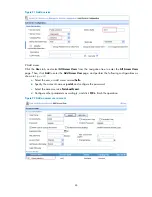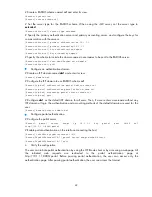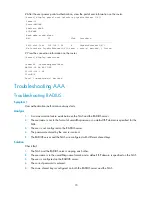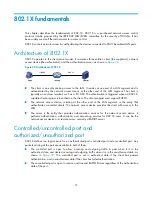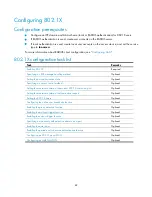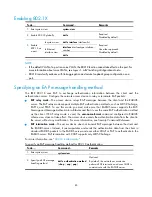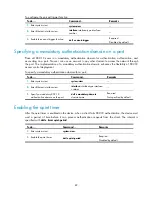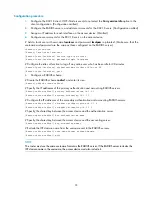
79
Configuring 802.1X
This chapter describes how to configure 802.1X on an HP device. Also configure the port security
feature to perform 802.1X. Port security combines and extends 802.1X and MAC authentication. It
applies to a network (a WLAN, for example) that requires different authentication methods for different
users on a port. Port security is beyond the scope of this chapter. It is described in "
NOTE:
802.1X is available only on a SAP interface card in bridging mode.
HP implementation of 802.1X
Access control methods
HP implements port-based access control as defined in the 802.1X protocol and extends the protocol to
support MAC-based access control.
•
With port-based access control, once an 802.1X user passes authentication on a port, any
subsequent user can access the network through the port without authentication. When the
authenticated user logs off, all other users are logged off.
•
With MAC-based access control, each user is separately authenticated on a port. When a user
logs off, no other online users are affected.
For more information, see "
."
Using 802.1X authentication with other features
VLAN assignment
Configure the authentication server to assign a VLAN for an 802.1X user who has passed
authentication. The way that the network access device handles VLANs on an 802.1X-enabled port
differs by 802.1X access control mode.
Access control
VLAN manipulation
Port-based
Assigns the VLAN to the port as the default VLAN. All subsequent 802.1X
users can access the default VLAN without authentication.
When the user logs off, the previous default VLAN is restored, and all other
online users are logged off.
MAC-based
•
Assigns the VLAN of the first authenticated user to the port as the default
VLAN. If a different VLAN is assigned for a subsequent user, the user
cannot pass authentication.
•
If the port is a hybrid port with MAC-based VLAN enabled, maps the
MAC address of each user to the VLAN assigned by the authentication
server. The default VLAN of the port does not change. When a user logs
off, the MAC-to-VLAN mapping for the user is removed.

